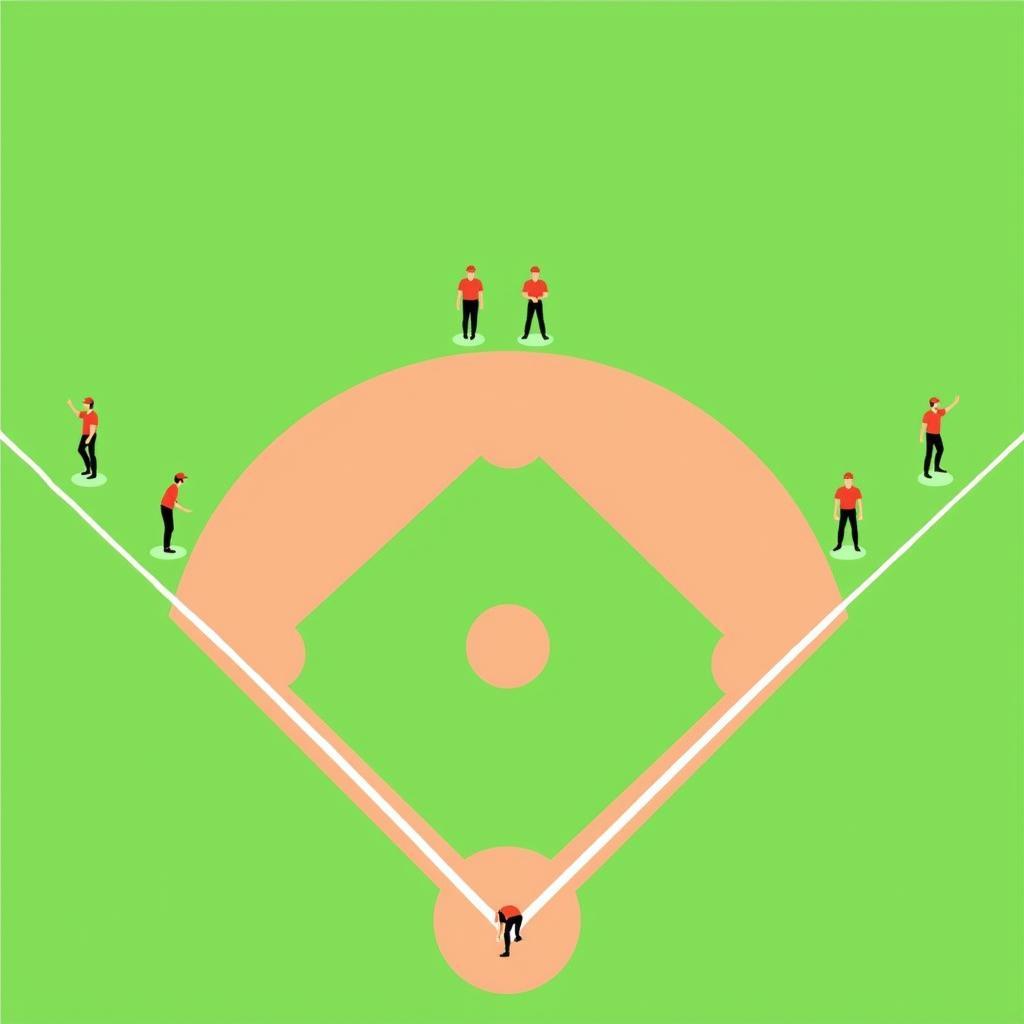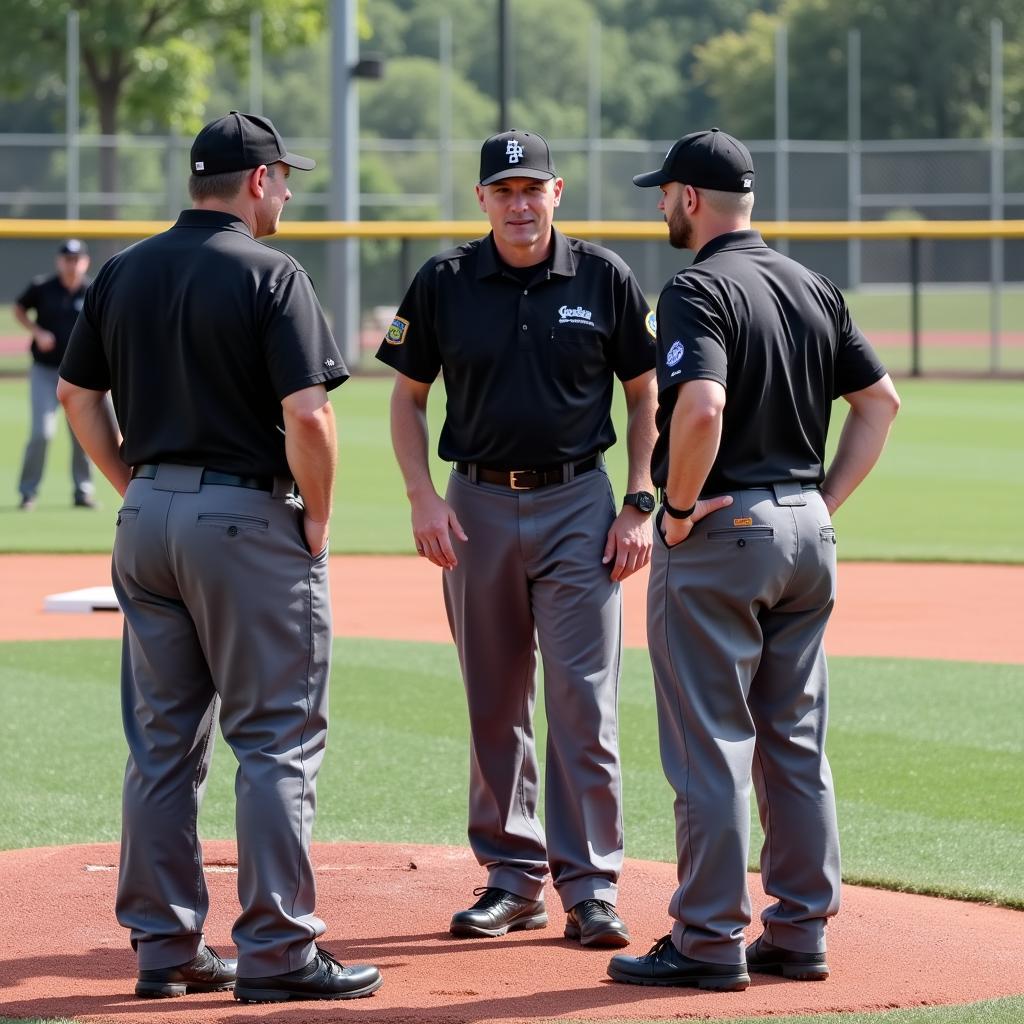Understanding the Umps Diamond in Baseball
October 13, 2024The “Umps Diamond” is a term you might hear tossed around in baseball discussions, but what exactly does it mean? It’s not about a literal diamond of precious gems, but rather a figurative one that’s crucial to how the game is officiated. This article dives deep into the concept of the umps diamond, its significance, and how it influences fair play on the baseball field.
What is the Umps Diamond?
 Umpire Positioning on a Baseball Field
Umpire Positioning on a Baseball Field
In baseball, the “umps diamond” refers to the positioning of the four umpires on the field. Each umpire takes responsibility for a specific area, and when viewed together, their positions form a diamond shape – hence the name. This strategic placement allows for optimal coverage and decision-making for various in-game situations.
The Four Points of the Umps Diamond
Let’s break down the roles and responsibilities associated with each point of the umps diamond:
1. Home Plate Umpire
- Positioning: Stands behind home plate, typically in a crouched position.
- Primary Responsibilities:
- Calling balls and strikes
- Determining fair/foul balls hit in their vicinity
- Making calls on plays at home plate (safe/out, plays on the batter, etc.)
2. First Base Umpire
- Positioning: Stands along the first base line, typically in foul territory.
- Primary Responsibilities:
- Making calls on plays at first base (safe/out, force outs, etc.)
- Observing fair/foul calls on balls hit down the right field line
- Monitoring the runner at first base (balks, interference, etc.)
3. Second Base Umpire
- Positioning: Stands in the outfield grass, roughly between second base and the pitcher’s mound.
- Primary Responsibilities:
- Making calls on plays at second base (safe/out, force outs, etc.)
- Observing runner interference and fielder obstruction
- Assisting other umpires on calls within their field of vision
4. Third Base Umpire
- Positioning: Stands along the third base line, typically in foul territory.
- Primary Responsibilities:
- Making calls on plays at third base (safe/out, force outs, etc.)
- Observing fair/foul calls on balls hit down the left field line
- Monitoring the runner at third base (balks, interference, etc.)
Importance of the Umps Diamond
 Umpires Conferring During a Baseball Game
Umpires Conferring During a Baseball Game
The umps diamond is not just about positioning; it’s about teamwork and collaboration. Each umpire has a primary area of responsibility, but they also work together to ensure fair calls are made. This coordinated effort is essential for:
- Optimal Field Coverage: The diamond formation allows umpires to effectively cover all areas of the field, minimizing blind spots and ensuring that plays are properly adjudicated.
- Multiple Perspectives: With umpires stationed at different points, they can offer varying perspectives on a single play, reducing the chance of bias or error.
- Communication and Collaboration: The umps diamond facilitates communication amongst the umpiring crew. They can quickly confer with each other on close calls, ensuring a more accurate final decision.
The Umps Diamond: More Than Just Positioning
While the physical diamond shape formed by the umpires’ positions is significant, the real essence of the “umps diamond” lies in the teamwork, communication, and shared responsibility it represents.
“The best umpiring crews are the ones that operate as a cohesive unit,” says former MLB umpire Jim Joyce. “It’s about trusting your partners, knowing their strengths and weaknesses, and being able to anticipate each other’s moves.”
This concept of the “umps diamond” highlights the essential role umpires play in maintaining the integrity and fairness of baseball. It’s a reminder that despite the challenges and pressures they face, umpires strive to make the best possible calls, working together to uphold the spirit of the game.
Frequently Asked Questions about the Umps Diamond
1. Do the umpires always stay in the diamond formation?
While the diamond formation is the standard, umpires may adjust their positioning slightly depending on the situation, such as the number of outs, the speed of the runners, or the batter’s tendencies.
2. What happens if an umpire gets injured during a game?
Typically, the remaining umpires will redistribute themselves to cover the field effectively. In some cases, a standby umpire may be available to step in.
3. Can technology replace the need for the umps diamond?
While technology like instant replay has become increasingly prevalent in baseball, the human element of umpiring remains crucial. The umps diamond, with its emphasis on teamwork and communication, ensures a comprehensive and nuanced approach to officiating the game.
4. Are there different umps diamond formations for different levels of baseball?
The basic concept of the umps diamond remains consistent across various levels of baseball, though there might be slight variations in positioning based on league rules and the age and skill level of the players.
5. Does the umps diamond affect the way players approach the game?
Players are undoubtedly aware of the umpires’ positioning and may adjust their baserunning or fielding strategies accordingly. However, the fundamental goal remains the same: to play by the rules and strive for victory.
Need Help? Contact Us!
For any inquiries or assistance, please don’t hesitate to contact us. Our dedicated customer support team is available 24/7 to assist you.
Phone Number: 0963418788
Email: [email protected]
Address: 2M4H+PMH, Phường Nghĩa Thành, Gia Nghĩa, Đắk Nông, Việt Nam.